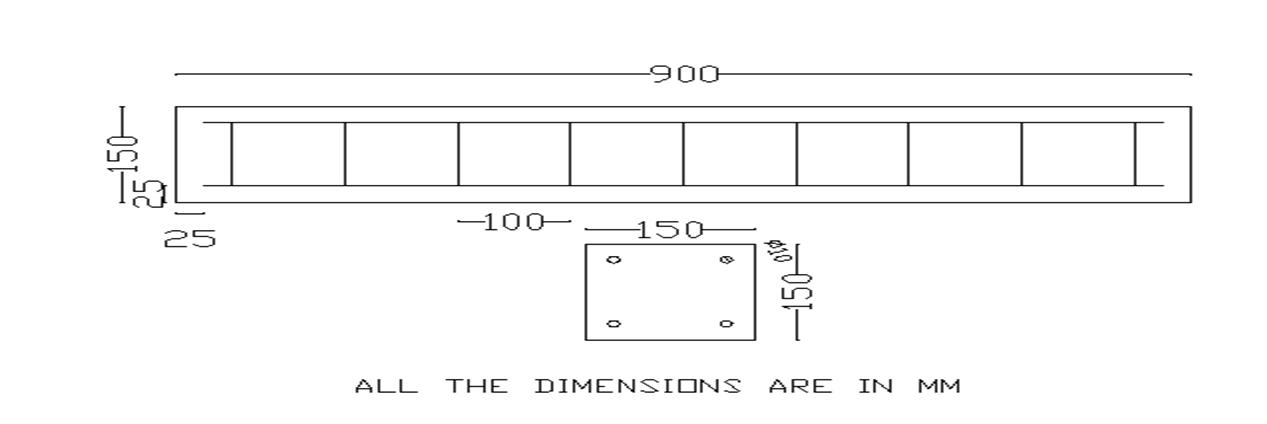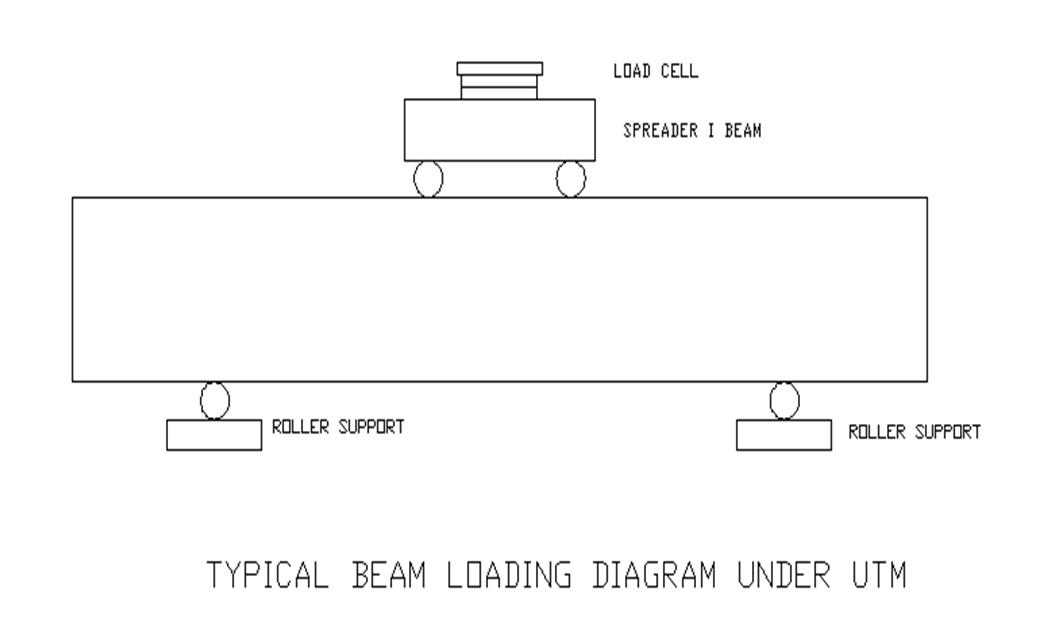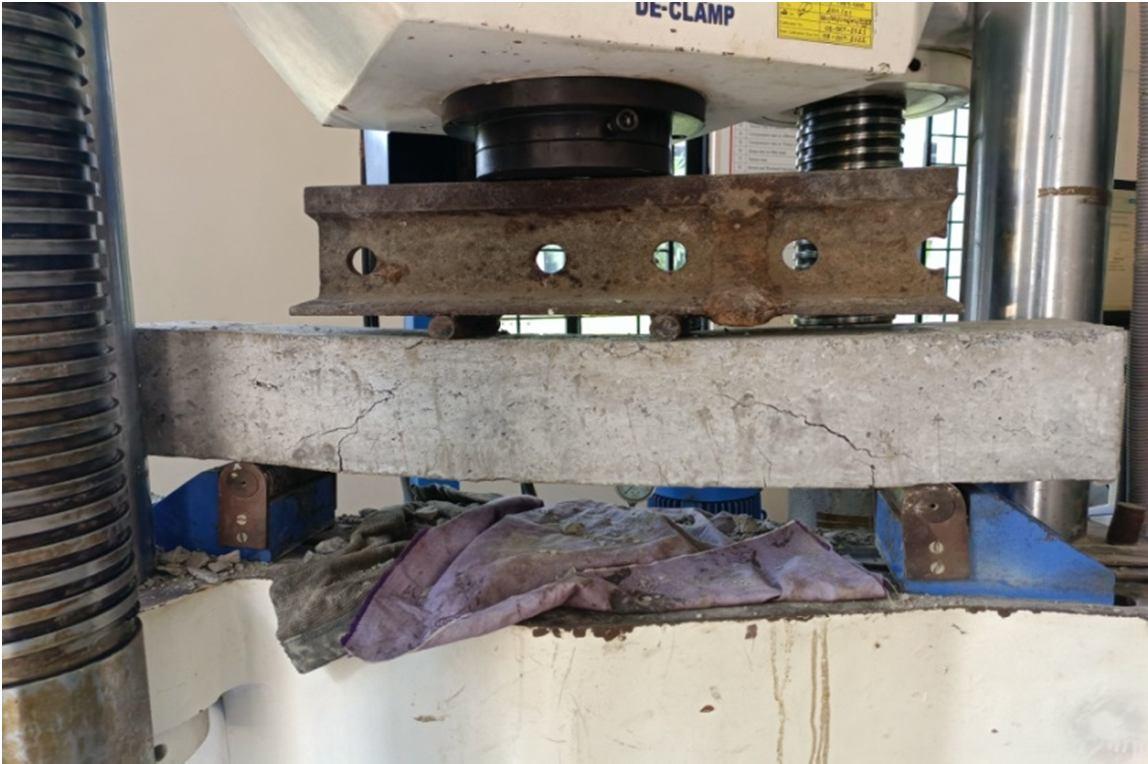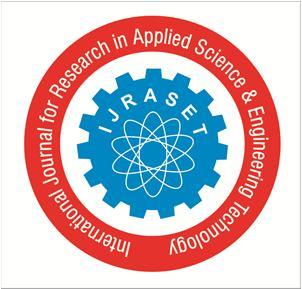

Flexural Behavior of Fly ash and GGBS Based Ambient Cured Geopolymer Concrete Beams
Abstract: Concrete is the world’s most versatile, durable and reliable construction material. Next to water, concrete is the most used material, which required large quantities of Portland Cement. Ordinary Portland Cement production is the major generator of carbon di oxide, which polluted the atmosphere. In addition to that large amount energy was also consumed for the cement production. Hence, it is essential to find an alternative material to the existing most expensive, most resource consuming Portland Cement.The study describes experimental investigation on flexural behavior of reinforced GPC. A total of eighteen beams were tested. From this, nine were of M20 mix, i.e., conventional concrete beams while nine were of geopolymer concrete,from this nine beams, three beams with the ratio of binder i.e., flyash:GGBS ratio as 75:25, other three with 70:30 while remaining three beams with 65:35. Also, 12 cubes & 12 cylinders were also casted and tested for compressive strength and split tensile strength respectively. From them, three were of conventional concrete while other nine of GPC with three different ratios as mentioned above. The reinforcement was designed considering a balanced section for the expected characteristic strength. All the beam specimens were tested under two point static loading. The studies demonstrated, the study of conventional and geopolymer concrete beams related to deflection, first load at which crack appeared and their crack patterns.
Keywords: Geopolymer concrete, Conventional concrete, Flyash, GGBS, Deflection, Ultimate load, Crack pattern, Compressive strength, split tensile strength.
I. INTRODUCTION
The term GP was firstly applied to describe a family of alkaline alumina silicate binders formed by the alkali activation of alumina silicate materials. GP technology was introduced by Prof. Joseph Davidovits in 1978. In our project we made an attempt to study strength properties of geo polymer concrete using low calcium fly ash and blast furnace slag in different percentages replacing the OPC. Sodium silicate and sodium hydroxide solutions of 10molarity were used as alkaline solution. Since the geo polymer binder consists entirely of fly ash and GGBS, there has been a common perception that geo polymer concrete would develop its strength very slowly or require heat curing. Portland cement systems containing high volume replacement of fly ash or GGBS and many geo polymer binders do develop compressive strength slowly. However, this particular geo polymer concrete develops its strength quite rapidly with design strength Typically achieved after 7 days under laboratory conditions. Strength development at early age (up to 3 days) is sensitive to ambient temperature but adequate early strength would be expected if the concrete temperature is above approximately 20°C. This paper presents information on replacement of complete binder cement with the mixture of flyash and GGBS with balanced section. This paper covers the materials, mix proportions of conventional as well as geopolymer concrete. This paper considers reinforced GPC and conventional beams with appropriate binder composition to study the flexural parameters of beams such as , Deflection, compressive strength, load at which the first crack appeared and also its crack patterns. Eighteen beams were casted, out of which nine were designed under geopolymer concrete beams while other nine as conventional concrete beams for research. Also, compressive strength and split tensile strength of cubes and cylinders respectively were also studied. Beams designed in this research where designed as Balanced section. And the curing of GPC was ambient type was for conventional it was pond curing.
II. MATERIALS USED

1) Sand: Locally available river sand was used as fine aggregate. The test carried out on fine aggregates is mentioned in table below.
2) Cement: Ordinary Portland cement (ACC 43 grade) is used for throughout casting of normal concrete specimens.
3) Aggregate: A crushed ballast rock of 20mm size was used as coarse aggregate. The following test were carried out on the coarse aggregate samples.
4) Flyash: Fly ash used in this study was obtained from coal burning power station, Jaysingpur ,from grading zone II.

5) GGBS: GGBS used in this study was obtained from MIDC, Miraj.
6) Alkaline Activator: Alkaline activators made the day before use by mixing NaOH with aquades thus concentrating 10M. The solution was mixed with Na2SiO3 with ratio between Na2SiO3/ NaOH is 2.
Samiya Shakir Tamboli1 , S. P. Deshmukh2
1M Tech Student, 2Assistant Professor, Sanjay Ghodawat University, Kolhapur
International
Fineness
Standard
ISSN: 2321 9653; IC Value: 45.98; SJ Impact Factor: 7.538

10 Issue IX Sep 2022 Available at www.ijraset.com
Table 1 Results of Sand
value
Table 2 Results of Cement
Standard value for OPC
10% max
min >30min
<600min
Table 3 Results of Aggregate
Water absorption
Value
5.17%
1.07%
Gravity 2.58
test 6.41%
Table 4 - Chemical Analysis of Flyash and GGBS
MATERIAL LOI SiO2 Al2O3 Fe2O3 CaO MgO Na2O K2O TiO2 Mn2O3 SO3
FA 0.76 62.10 27.44 4.57 0.83 0.55 0.04 1.17 1.09 0.04 0.40
GGBS 2.1 43.4 12.5 0.82 40.3 0.75 0.26 0.35 0.5 0.14 0.34
MIX DESIGN
are available for GPC.
Unlike OPC’s, GPC’s
from design procedure found in literature of
based on binder content, alkaline /binder ratio, flyash/GGBS ratio, type of curing
this
studying reference papers& literature review’s, the mix proportion for the flyash
GGBS ratio of
of curing(
was studied in this research paper.
Table 5 Quantities for Geopolymer Concrete (75:25,70:30,65:35 respectively)
INGREDIENTS
QUANTITY (kg/m3) BEAM CUBE CYLINDER
GGBS 1.58 1.57 2.205 0.27 0.265 0.371 0.42 0.417 0.59
FLYASH 4.73 4.72 4.095 0.80 0.796 0.69 1.26 1.252 1.085
1 1 1 0.168 0.168 0.168 0.265 0.265 0.265

Na2SiO3 2 2 2 0.337 0.337 0.337 0.53 0.53 0.53
FINE AGG 14.25 14.25 14.25 2.401 2.401 2.401 3.77 3.77 3.77
COARSE AGG 26.46 26.46 26.46 4.459 4.459 4.459 7.013 7.013 7.013
TOTAL WATER 2.167 2.167 2.167 0.365 0.365 0.365 0.574 0.574 0.574
EXTRA WATER 0.07 0.07 0.07 0.013 0.013 0.013 0.02 0.02 0.02
International
Table 6
Science
Engineering Technology (IJRASET

ISSN: 2321 9653; IC Value: 45.98; SJ Impact Factor: 7.538 Volume 10 Issue IX Sep 2022 Available at www.ijraset.com
Conventional
(kg/m3)
BEAM CUBE CYLINDER
CEMENT 3.78 1 1.66
FINE AGG 9.85 2.98 4.4
COARSE AGG 13.32 3.74 5.9
WATER 2.00 0.6 0.9
ADMIXTURE 0.045 0.01 0.02
IV. PREPARATION OF TEST SPECIMEN AND CURING
The cube of 150X150X150 mm3 , cylinders of 150 mm X 300 mm and beams of 900X150X150 MM3 were casted . Three for conventional type study and three for GPC study in case of cube and cylinders while for the beams, nine were casted for conventional study and nine for GPC. Hand mixing was used. The concrete was placed in the moulds in three layers of equal thickness and each layer was vibrated until the concrete was thoroughly computed. Specimens were demoulded after 24 hrs. the conventional beams were water cured while GPC beams were ambient cured for 28 days after casting. After curing, the test specimens were tested for compressive strength, split tensile strength, deflection, first crack load & cracking patterns were observed.
V. EXPERIMENTAL INVESTIGATION
1) Specimen Details: The beam specimen were 150mm wide, 150mm deep in cross section. They were 900mm in length. All the beams were designed for balanced section . T he clear cover of the beam was 25mm, while cube of 150 mmX 150mm X 150mm and cylinder of 150mm X 300mm.
2) Reinforcement Details: High yield strength deformed steel bars of diameter 10 mm was used as the longitudinal reinforcement in the specimens. Two legged vertical stirrups of 6mm diameter at a spacing of 100 mm centre to centre were provided as shear reinforcement. Four stirrups were provided in each beam specimen to resist shear failure.
Figure 1. Geometry of beam specimen (All dimensions are in mm)


VI. TEST PROCEDURE
The image of test setup is shown. The beam specimen was mounted on UTM of 1200 KN capacity. The behavior of the beam was observed carefully and the crack patterns, load applied , deflection were observed. The load was gradually applied and the behavior of the beam was observed carefully, and the first crack was also observed and recorded.

VII. RESULT AND DISCUSSION
1) Compressive Strength Of Conventional Concrete Cubes: Compressive test of concrete has been taken by testing cube of size 150x 150x150mm after 7 and 28 days of curing.

2) Splittensile Strength Test On Conventional Concrete Cubes: Split tensile strength test was taken on cylinders after 7 and 28 days respectively. Whose results are discussed below
Table 7 Average Value of Compressive strength:
No. Concrete
days strength 28 days strength Average(MPa) 7 28
1 Conventional 6.7 29.02
2 Concrete 6.8 30.22 6.7 30.60
6.8 32.57
1 Geopolymer 16.96 39.65
Concrete 16.58 41.36 16.47 42.85
3 (75:25) 15.86 47.56

1 Geopolymer 18.71 50.26
2 Concrete 17.52 50.02 17.85 49.68
(70:30) 17.32 48.77
Geopolymer 19.21 58.2
2 Concrete 18.98 63.6 18.74 60.44
(65:35) 18.02 59.52

Table 8 Average value of Split Tensile Strength
No. Concrete
days strength 28 days strength Average(MPa) 7 28
1 Conventional 1.11 3.26
2 Concrete 1.07 3.78 1.1 3.55
1.12 3.63
1 Geopolymer 1.38 3.02
2 Concrete 1.25 3.11 1.25 3.06
(75:25) 1.12 3.06
Geopolymer 1.39 3.18
Concrete 1.46 3.19 1.4 3.23
(70:30) 1.37 3.34
1 Geopolymer 1.43 3.86
Concrete 1.54 3.55 1.48 3.76
(65:35) 1.49 3.89
2321 9653;


First crack load in KN







are 1.25 N/mm2,1.4 N/mm2 & 1.48 N/mm2 respectively while after 28 days are 3.06 N/mm2,3.23 N/mm2,3.46 N/mm2, respectively.
4) Average ultimate load applied on Conventional concrete beams is 55 KN while that of geopolymer concrete beams is 80 KN.
5) Deflection of GPC beams of the ratios 75:25, 70:30, & 65:35 in average of all the tested

in the group of three is 7.56mm, 9.63mm & 7.383mm respectively, while that of conventional
is 11.99mm.

Science
Engineering Technology (IJRASET
ISSN: 2321 9653; IC Value: 45.98; SJ Impact Factor: 7.538

Volume 10 Issue IX Sep 2022 Available at www.ijraset.com
6) Crack pattern was Diagonal tension failure in both the types of beams while in some cases it was flexural failure.
7) Average value of first crack appeared in conventional concrete beams is 37 KN while that of GPC beams with different ratios is 75:25 as 48.83 KN, 70:30 as 9.63 KN &that of 65:35 is 42.5 KN.
IX. CONCLUSION
The experimental investigation carried out to study properties of geopolymer concrete & conventional concrete and concluded the following:
1) The split tensile strength of geopolymer concrete is slightly more than that of conventional concrete. Split tensile strength of mix 65:35 is more than that of 70:30 and 75:25, tested after 7 as well as 28 days of curing.
2) The split tensile strength of mix 65:35 is more than other two mixes.
3) The compressive strength of GPC cubes is greater than that compressive strength of conventional beams.
4) Compressive strength of mix 65:35 is more than other two mixes.
5) Comparing Load and Deflection rates, deflection of GPC beams is slightly less as load bared by GPC beams is more. Deflection in conventional beams is slightly more as load bared is less as compared to GPC.
6) First crack occurred in GPC at that particular load is 16% greater than that of conventional concrete.
7) Crack pattern observed was Diagonal tension failure in both the types of beams while in some cases it was flexural failure.
X. ACKNOWLEDGEMENT
It is a genuine pleasure to express my deep sense of thanks and gratitude to my guide and mentor Prof S.P.Deshamukh, Department of Civil Engineering, Sanjay Ghodawat University, Kolhapur. His dedication and keen interest above all his overwhelming attitude to help his students had been solely and mainly responsible for completing my work. His timely advice, meticulous scrutiny, scholarly advice and scientific approach have helped me to a very great extent to accomplish this task.
I owe a deep sense of gratitude to our PG coordinator Prof C. S. Patil, Department of Civil Engineering, Sanjay Ghodawat University, Kolhapur for his keen interest at every stage of my research. His prompt inspirations, timely suggestions with kindness, enthusiasm and dynamism have enabled to complete mythesis.
I take my deep sense of gratitude and reverence to Dr. A. D. Katdare, Department of Civil Engineering, Sanjay Ghodawat University, Kolhapur who constantly motivated, supported, encouraged and guided me. I would like to thank him for providing me the requisite opportunities and facilities
I profusely thank all the staff of civil engineering Department, Sanjay Ghodawat University, Kolhapur for their kind help and co operation throughout my studyperiod.
REFFERENCES
[1] Dttatatreya J K , Rajamane N P , Sabitha D, Ambily P S , Nataraja M C “Flexural Behavior of Reinforced Geopolymer Concrete beams”.International journal of Civil and Structural Engineering Vol.2, No.1,2011
[2] Subhash V P, Yuwaraj M G , Sanjay S J “Mix Design of Fly Ash Based Geopolymer Concrete”.Advances in Structural Engineer 2015.
[3] Department of Civil Engineering, Logistical Engineering University, Chongquing 401311, China(2017)
[4] Medheswaran C K, Ambily P S, Rajamane N P, Arun G “Studies on flexural behaviour geopolymer concrete beams with lightweight aggregates”.International journal of civil and structural engineering Vol.4, No.3,2014.
[5] Pradip Nath, Prabir Kumar Sarker “ Effect of GGBS on setting, workability and early strength properties of flyash geopolymer concrete cured in ambient condition”. 2014
[6] Tung T T, Thong M P, Hong Hao “ Experimental and analytical investigation on flexural behaviour of ambient cured geopolymer concrete beams reinforced with steel fibers”.Centre for infrastructure Monitoring and Protection, 2019.
[7] Ruby Abraham, Deepa Raj S, Varghese Abraham “Strength and Behaviour of Geopolymer Concrete Beams”.International journal of innovative research in science engineering and technology. Vol.2, 2013

[8] S Kumaravel, S Thirugnanasambandam “Flexural Behaviour of Geopolymer Concrete Beams”.
[9] Noor S Y, Mohamad A E, Lesley H S, Aly S “Shear Strength of fly ash based geopolymer reinforced concrete beams”.International journal of advanced engineering research and studies, 2013.
[10] Nindyawati, Sri Umniati B, Puput Risdanareni “ Flexural test of Flyash based Geopolymer Concrete Beams”.MATEC web of conference,2017
[11] Khao T N, Namshik A, Tuan A L, Kihak L “Theoretical and experimental study on mechanical properties and flexural strength of fly ash geopolymer concrete”.Elsevier, 2015.

